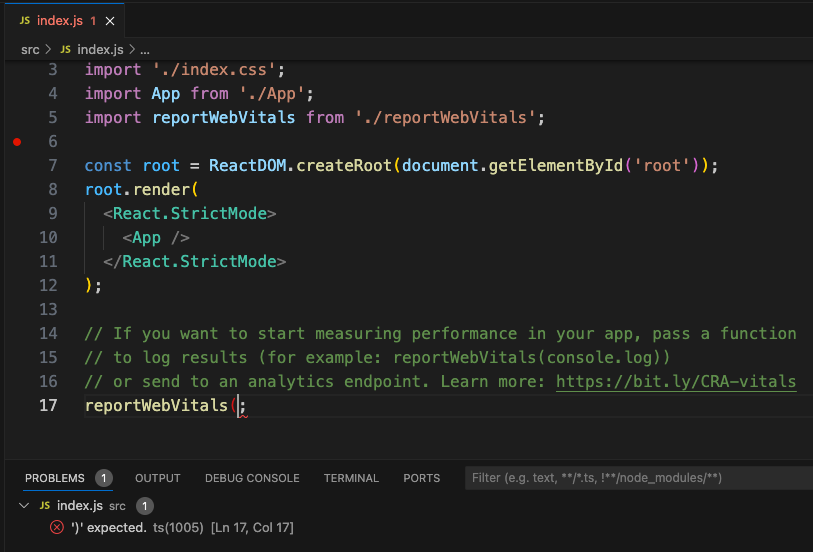- React Native In Visual Studio Code Free
- React Native In Visual Studio Code
- React Native In Visual Studio Code 2019
- React Native In Visual Studio Code Download
Sign up or log in and hit the blue button on the top right corner of the portal that says Add new and select Add new app from the dropdown menu. Enter a name and an optional description for your app. Select the appropriate OS (Android or iOS) and select React Native as the platform. Hit the button at the bottom right that says Add new app. Once you have an emulator running, you can create a new React Native app, load it in VS Code, and start debugging. Open command prompt, run ‘react-native init aNewApp’ Open the created ‘aNewApp’. Visual Studio Code and WebStorm are two popular editors for developing React Native/Expo apps. These editors have lots of useful features, such as syntax highlighting, git integration and auto completion.
Visual Studio Code editor used by millions of developers come from every programming language arena. Action actina gameon driver download for windows 10. I’m also using Visual Studio Code editor from beginning of my development career in react native. As I know VS Code editor is one of the best code editor I’ve every worked in. So in today’s tutorial we would learn about Setup React Native Environment in Visual Studio Code Editor in Windows MAC Linux operating system. After setting up react native for VS Code editor it will show us coding suggestions with maximum durability, which makes a beginner developer coding easy. All we have to do is type a Code beginning keyword and press CTRL+Space to show the suggestion matched to that keyword.

Contents in this project Setup React Native Environment in Visual Studio Code Editor in Windows MAC Linux Tutorial:
1. The first step is to download latest Stable version of Visual Studio Code editor from their website. Here is the link. VS Code editor is free for everyone.
2. After downloading install VS Code editor on your operating system.
3. Now open VS Code editor -> View -> Command Palette…
4. Search Extensions: Install Extensions in the Search box.5. Search a Plugin named as React Native Tools.
6. Click on Install button to install the React Native Tools plugin. There are other plugins for React Native, you can also install them from here as per your requirement.
Here you go guys, Now your VS Code Editor is ready to use with React Native 🙂 .
Also Read :
The very first step to start development in React-Native is to install the right tools to setup the environment correctly. I’m working on MacOS Catalina and I already have Xcode 11 installed on my machine which is one of the pre-requisites to run the iOS App.
Install the following dependencies for React-Native:
NodeJS: https://nodejs.org/en/download/
The recommended way to install Node is using Homebrew from your Terminal:
Watchman: In react-native, Watchman watches the source code for any changes and rebuilds them.
Install XCode from App Store.
Cocoapods: This is the Dependency Manager for iOS & Mac projects.
This requires you to enter system password.
Install Visual Studio Code for Mac from here. You might face issues on Mac OS Catalina to run VS Code due to Notarization requirements. You can check out this post for more details.

Create the folder inside say your Documents folder on your Mac as below:
Open VS Code and open New Terminal and type the following command to create a new React-Native App:
Come back to the MyApp folder and run the below command to run your App in the iOS simulator:
This will install and launch the App in your iOS simulator. The first time might be very slow. It might be helpful to launch your simulator beforehand.

Running on Android:
Install the Android Studio from here, which will install the Android SDK and the required emulator. I’m using the Android 10 emulator for Pixel XL. Vvikoo driver download for windows 10.
Open the MyApp folder in VS Code to make further changes.
Issues
Running the Android App causes issues while launching the Emulator. The error message is: React Native adb reverse ENOENT
Starting with macOS Catalina, your Mac uses zsh as the default login shell and interactive shell. You can make zsh the default in earlier versions of macOS as well.
So on your Mac: Action act sierra triton3 driver.
1 – Open your .zshrc file:
2 – if .zshrc file doesn’t exist, you need to create one & open again(Step 1)

3 – Add this to your .zshrc file
4 – Save and close

5 – Compile your changes
& make sure to restart your terminal.
React Native In Visual Studio Code Free
Run the command in the Terminal and you’ll see something like below if everything is fine:
Android Debug Bridge version 1.0.41
React Native In Visual Studio Code
Version 30.0.0-6374843
React Native In Visual Studio Code 2019
Installed as /Users/<username>/Library/Android/sdk/platform-tools/adb
You can also run the code in your VS Code Terminal and see the same output.
React Native In Visual Studio Code Download
The path to Android SDK is available in the Configure button -> SDK Manager (at the bottom right) when you launch Android Studio.
